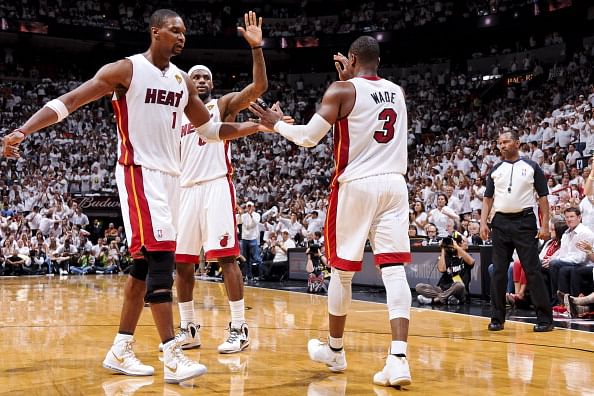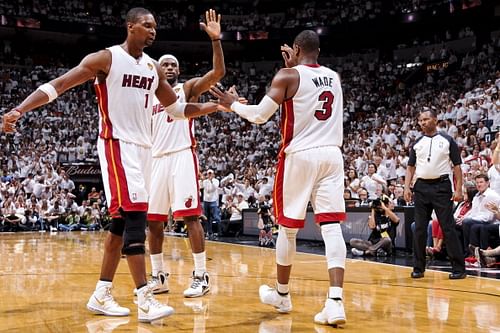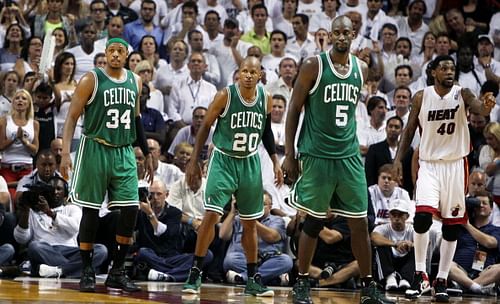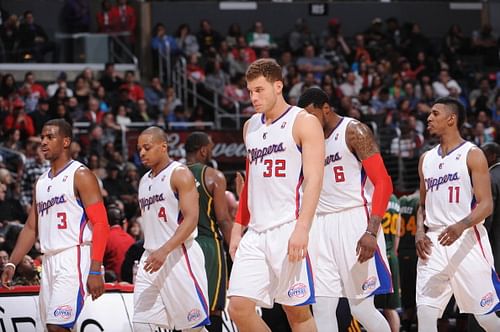
Love them or hate them, the Big 3's are here to stay

In the world of basketball, it would be criminal to forget the summer of 2010; for it was in July of that year that a revolution began.
LeBron James’ infamous broadcast on national television to take his “talents to South Beach and join the Miami Heat” prompted great furore. It brought anger even to the most disloyal of Cleveland fans. But most importantly it brought with it, fear.
With Dwayne Wade already on their books, the Heat brought in free-agent Chris Bosh along with James. It was not long before the media labelled them ‘The Big 3′. Assembling a team with multiple all-stars was the new blueprint to ‘buying a championship ring.’
Just ask the Boston Celtics. In 2007, a mad series of trades saw Ray Allen, Kevin Garnett and Paul Pierce come together. Dubbed the “Boston Three Party”, they stormed to the finals with young rookie point guard Rajon Rondo running the show. They ended up defeating the Western Conference Champions, LA Lakers, four games to two.

But things wouldn’t be as easy for the Heat. Overhyped, all wasn’t going according to plan in the Miami camp at the start. Gradually meeting with the expectations that caused such a stir during the off-season, they entered the NBA finals as favourites. They came up against a Dallas Mavericks side led by the ever reliable Dirk Nowitzki, looking for their first championship win.
The Mavericks ended up running riot, especially in the fourth quarter of games. Nobody could match Nowitzki’s clutch shooting, not even ‘King’ James, who to put it subtly, choked, letting the Mavericks come up top in six (4-2). With the advent of the ‘Big 3’, this is probably one of the last times one will ever see a team built around a solitary superstar. Nowitzki may have won Finals MVP – and deservedly so – but he did have his supporting cast of Jason Kidd and Jason Terry to thank.
That was 2011; two seasons ago. Last season saw Miami with even more cohesion as they reached the play-offs and the Conference Finals with relative ease. Their path to finals was blocked by the Boston Celtics. Against the ageing first real Big 3 of the 21st century they took the first two games. However, with bags of experience, the Celtics stormed back, winning the next three. Once again, it seemed like the Heat would fail at the final (or second to last) hurdle. That wasn’t to be however, because they won the next two games and reached their second straight final, where they would face the newest and youngest threesome from Oklahoma City Thunder – Russell Westbrook, Kevin Durant and James Harden.
The diminutive triumvirate had taken the NBA by storm. Barring Thabo Sefolosha, Thunder players Durant, Westbrook, Harden, Kendrick Perkins and Serge Ibaka all made it to the 2012 All-Star ballots. In post-season, they breezed past defending champions Dallas Mavericks and Kobe Bryant’s Los Angeles Lakers. In the Conference finals San Antonio Spurs’ Big 3 of Tim Duncan, Frenchman Tony Parker and Argentinean Manu Ginobili, all arguably past their prime, simply couldn’t keep up with OKC’s young and upcoming.
Both Heat and Thunder had an identical regular season. The 2012 NBA Finals, on the other hand, told a different story. Westbrook and Durant, both 23, have the potential to be future hall-of-famers, but their inexperience showed, as they were no match for James and co. Miami obviously had learnt from last season’s loss, as had James who ended up as the Finals’ MVP. The championship finals – decided in five (4-1) – was one-sided and gave James and Bosh their first rings. Wade got his second, adding to the one he won in 2006 with Shaquille O’Neal.
The 2012/13 off-season hasn’t been any less dramatic (albeit less dramatic than the 2011 one which involved the lockout). The Lakers acquired all-star centre Dwight Howard from Orlando Magic in a massive four-team trade off. Steve Nash, one of the best ball-handlers of the era has seen also agreed to a trade from the Phoenix Suns. Even though Pau Gasol, Bryant and Nash are all the wrong side of 30, anybody who writes the Lakers off would be foolish.
On the other side of the country, Heat pulled off a major coup by signing veterans Ray Allen and Rashard Lewis. Not only do they have the best starting five in the league, they now have the best bench too. Boston may have lost Allen to rivals Miami, but Rondo is more than capable of filling his shoes. As long as he keeps his attitude in check, he could provide Garnett and Pierce one final hurray as their careers wind down.
The Big 3 formation is becoming more of a prerequisite than anything else. But it isn’t always successful. Nevertheless, when it does work, few complain. Every team is looking at any way possible of acquiring a formidable stockpile of superstars.
The New York Knicks have Carmelo Antony, Tyson Chandler and Amar’e Stoudemire; effective only if they can stay fit, put their egos aside and find some togetherness. The Chicago Bulls have Luol Deng, Joakim Noah and Derrick Rose, even Carlos Boozer for that matter; play-off material sure, with some luck. The LA Clippers aren’t to be left behind; they have big-dunking Blake Griffin and DeAndre Jordan assisted by CP3 a.k.a. Chris Paul.

As flawed as it may seem, some franchise owners and coaches have probably found an easy strategy on the long road to the championships. But the disparity between the bad teams and the good is so big that one can only hope it doesn’t affect the quality of the league. This is the way forward. Whether it is good or bad for the league is open to interpretation.
The coach’s chalkboard no longer has a single ‘x’ marking whom to pass the ball to in a buzzer-beating situation, it now has three.